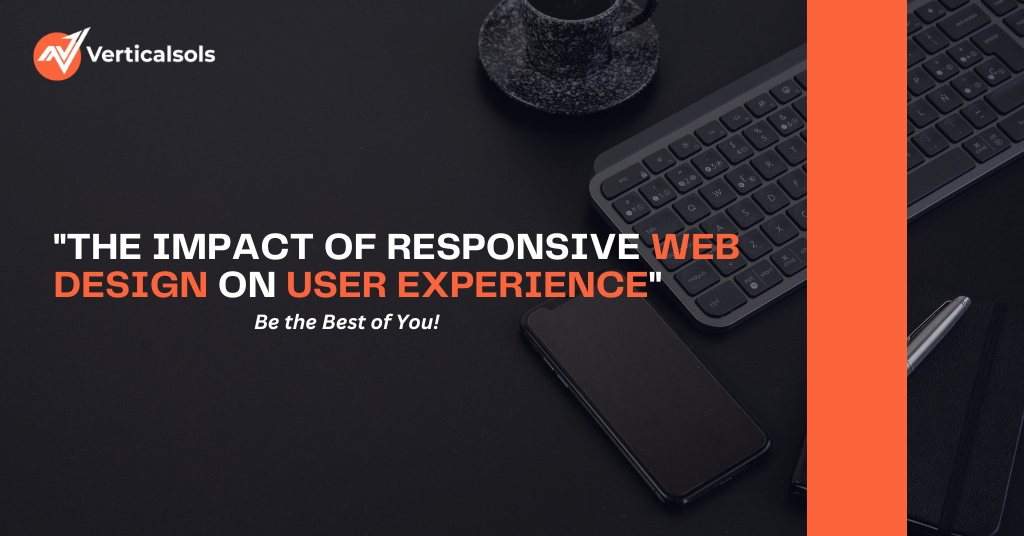The Impact of Best Responsive Web Design on User Experience

Verticalsols
12/06/2023
9 minutes

JOIN OVER 7,000+ SUBSCRIBERS
Don't miss out on Insights to boost your business.
Email*

I. Introduction:
A. Responsive web design is a design approach that guarantees websites adapt to different devices easily. Responsive design allows websites to shift dynamically to different screen sizes and resolutions by utilizing flexible layouts and fluid grids. This versatility is critical in today's digital landscape, when people access websites via a variety of devices such as smartphones, tablets, and desktop PCs. The purpose of responsive design is to give the best possible user experience regardless of the device.
B. User experience is extremely important in web design since it directly effects user pleasure and engagement. A favorable user experience leads to improved usability, accessibility, and overall satisfaction when interacting with a website. It considers things like ease of navigation, intuitive design, quick loading times, and content readability. To retain visitors, boost conversions, and develop a strong brand reputation in today's competitive online world, organizations must priorities user experience.
C. Key Point: Responsive web design improves user experience across devices by guaranteeing constant usability, accessibility, faster loading times, flexibility to different screen sizes, and seamless navigation and content consumption.
II. Recognizing Responsive Web Design:
A. Responsive web design is based on core concepts that drive its execution. These ideas include fluid layouts and flexible grids, which allow website elements to shrink and adapt appropriately to different screen sizes.
B. Fluid grids and flexible layouts allow websites to adjust to different devices, ensuring an optimal viewing experience. This method replaces fixed pixel measurements with relative units, allowing the content to adapt its size and layout automatically.
C. Responsive pictures and media queries contribute to the responsive design paradigm even further. Images are optimized and adapted to various screen resolutions, ensuring that they are neither too large nor too small. In contrast, media queries allow the implementation of specific CSS rules based on device parameters like as screen width or device orientation.
D. Responsive web design has intrinsic benefits over separate mobile and desktop websites. It reduces the need to keep different versions of a website up to date, lowering development and maintenance costs. Furthermore, responsive design ensures a uniform user experience across devices, removing any inconsistencies that could occur from having distinct sites for different platforms.
III. Improving User Experience Through Responsive Design
A. Responsive design is critical to delivering a consistent user experience across devices. Users can switch from one device to another with no interruptions or discrepancies in the website's appearance or functioning.
B. Responsive design has a huge impact on accessibility and usability. Responsive websites meet varied user needs and assistive technology by catering to a wide range of devices, ensuring inclusivity and enabling users of varying abilities to navigate and interact efficiently.
C. Quicker page load times are critical for keeping users' interest and lowering bounce rates. Responsive design improves speed by sending only the code and resources that are required based on the device's capabilities, resulting in faster loading times and more user satisfaction.
D. The adaptability of responsive design to different screen sizes and resolutions guarantees that content stays legible, visually appealing, and well-structured across devices. Users may easily ingest the content without having to zoom in or out or scroll excessively.
E. A positive user experience requires smooth navigation and information consumption. Responsive design guarantees that menus, links, and interactive components are easily accessible and work intuitively, allowing visitors to effortlessly traverse the website and consume content.
IV. The Effect on Mobile Users
A. The growing use of mobile devices emphasizes the significance of responsive design. Because more people are visiting websites via smartphones and tablets, it is critical to priorities mobile user experience.
B. A mobile-first approach is a design philosophy that recognizes and prioritizes the dominance of mobile devices. Designers can create interfaces that are specifically suited to give an amazing mobile user experience by considering the restrictions and unique features of mobile devices from the start.
C. Because it intelligently scales and arranges items to match multiple screen sizes, responsive design reduces the need for users to pinch and zoom to access content. This avoids the irritation and bother of attempting to see and interact with a desktop-centric website on a small mobile screen.
D. Touch interactions and gestures must be optimized for the best mobile user experience. Responsive design ensures that touch targets are correctly sized, reducing the likelihood of mis clicks and improving navigation. It also employs mobile-specific movements like swiping and tapping to provide natural and compelling interactions.
E. Mobile-friendly features and functionality, such as call-to-action buttons, location-based services, and streamlined checkout processes, improve the overall mobile user experience. These features cater directly to mobile users' demands and behaviors, making interactions easy and quick.
V. SEO Advantages of Responsive Design
A. In search results, Google's mobile-first indexing and ranking factors priorities mobile-friendly websites. Responsive design optimizes websites for mobile devices, increasing visibility and search engine results.
B. Responsive design provides intrinsic benefits such as consolidated website URLs and increased crawlability. Search engines can simply identify and index the website's content with a single URL for both mobile and desktop versions, minimizing the complexity of managing various URLs for different platforms.
C. Responsive design aids in the avoidance of duplicate content issues, which can have a negative influence on search rankings. There is no need to copy material across distinct mobile and desktop sites by maintaining a single version of the website that adjusts to multiple devices, eliminating the danger of duplicate content fines.
D. The ability of responsive design to provide a great user experience across devices leads to higher user engagement and lower bounce rates. Users are more likely to spend time researching information and engaging with a website that is visually appealing, easy to browse, and available on their preferred device, thus enhancing SEO metrics.
E. The benefits of local search are especially important for Houston-based businesses. Together with location-based optimization tactics, responsive design can help businesses rank prominently in local search results, drawing relevant local traffic and potential consumers.
VI. Best Practices for Responsive Design Implementation
A. It is critical for responsive design to priorities content and user needs. Determine the essential content and features that users require and ensure that they are accessible and well-presented across all devices, taking into account the restricted screen area on mobile devices.
B. It is critical to design for performance and load speed. Optimize images, reduce code and resources, and apply caching techniques to ensure quick loading times across all devices, improving user experience and SEO performance.
C. Testing across several devices and browsers is critical for identifying and resolving any usability or compatibility concerns. Conduct extensive testing to provide a consistent user experience across several devices, screen sizes, and major browsers.
D. Considering future devices and technologies is critical to future-proofing the responsiveness of your website. Prepare for upcoming technologies like as foldable screens and wearable gadgets by designing with adaptability in mind.
E. Working with web developers and designers to use their expertise is critical. Work collaboratively with responsive design experts to guarantee a successful implementation that corresponds with your business goals and user needs.
Case Studies and Illustrations
A. Display successful examples of responsive web design, emphasizing Houston firms who have successfully embraced responsive design. Discuss their design decisions and how they have improved user experience across devices.
B. Identify specific industries in Houston that have benefited from responsive design, such as e-commerce or service-based enterprises. Investigate how responsive design has helped them boost their online visibility and user engagement.
C. Discuss how responsive design deployment has resulted in measurable improvements in user experience, such as higher conversion rates, longer time on site, or lower bounce rates. Data and statistics should be shared to demonstrate the positive impact on user engagement and business outcomes.
Conclusion:
Finally, responsive web design is critical for improving user experience across devices by assuring usability, accessibility, and seamless interaction with websites. As Houston businesses attempt to satisfy the changing needs of their varied customer base, responsive design becomes increasingly important. We recognize the importance of offering outstanding user experiences at Verticalsols , and we specialize in providing comprehensive web development solutions, including responsive design. To provide a seamless and engaging user experience, our team of professionals specializes in creating flexible layouts, optimizing performance, and testing across devices. Verticalsols is dedicate d to assisting Houston businesses in thriving in the digital arena, whether it's by boosting loading times, optimizing touch interactions, or adding mobile-friendly features. Contact us immediately to harness the power of responsive design and give an outstanding online experience across all devices.
Table of Contents


Verticalsols
In this fast-paced digital landscape, I am dedicated to sharing my knowledge and insights with fellow marketers and entrepreneurs. Whether it's through blog posts, webinars, or consulting, I am committed to helping businesses navigate the digital maze and thrive in the digital age.
Related Posts
SOFTWARE DEVELOPMENT
HIRE DEVELOPERS
ABOUT US
- Verticalsols.com
- Address : 34 N Franklin Ave Ste 687#1936 Pinedale, WY 82941
Email :
info@verticalsols.comPhone :
+1 786 224 2151Find Us :
© 2022-2025
Verticalsols LLC